Foam Roller Resource
The foam roller is a tool used to do self-massage for muscle pain treatment, prevention, and maintenance. By utilizing constant, slow pressure over the affected area circulation is increased which improves you bodies ability to recover and heal. Tightened fascia (the connective tissue that surrounds muscles) unwinds and is able to lengthen again. The long-term effects of this are improved circulation, correcting muscle imbalances and relieving pain.
Some general foam rolling guidelines:
- You only need a few minutes. Up to 15 minutes for one very tight muscle group is the maximum.
- Begin by slowly lowering onto the foam roller to put gradual pressure on the muscle. Simply hold the position for about 30 seconds or until you are a little more comfortable. If you find yourself contracting the muscle as you lower, ease up on the pressure. You want the muscle to be relaxed.
- Roll gently and VERY slowly over the affected area. Seriously…VERY slowly.
- You will feel discomfort, and this is normal: when muscle fascia tightens, it becomes hard and sensitive. However, if you find the pain intolerable, do not push through it.
- Only go as deep as you are able to without contracting the affected muscle and remember to breath.
- Is rolling on the floor is to uncomfortable, you can always modify by using the wall instead.
- Avoid foam rolling over injured or inflamed areas, joints, or broken skin.
- Foam rolling is safe to do before stretching and exercise or even post exercise can be helpful.
- You can foam roll every day if you’d like, as long as it doesn’t make you sore.
Adductors
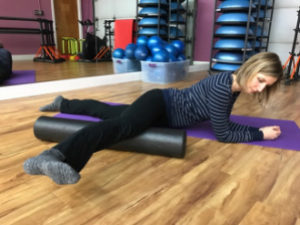 The hip adductors run along the inside of your thigh from your knee to your pelvis. Adductors can become tight from both inactivity or high impact activities like running or tennis. Tension here can result in pain in the low back or inside of the knee.
The hip adductors run along the inside of your thigh from your knee to your pelvis. Adductors can become tight from both inactivity or high impact activities like running or tennis. Tension here can result in pain in the low back or inside of the knee.
Adductors tend to be extremely tender so the weight of your leg should give you enough leverage to get good results. If it’s to much, try bending your knee. Rotating your leg and rocking your hips will help you find the most tender areas then just hold pressure.
Hamstrings
 Hamstrings are notorious for being tight. Although tension is common here, it usually arises from a lack of strength or unequal tension between other muscle groups around the thigh and hip so be sure to roll these along with the rest of the thigh and hip. Tension here can result in pain the back of the knee and can travel as far as the bottom of the foot.
Hamstrings are notorious for being tight. Although tension is common here, it usually arises from a lack of strength or unequal tension between other muscle groups around the thigh and hip so be sure to roll these along with the rest of the thigh and hip. Tension here can result in pain the back of the knee and can travel as far as the bottom of the foot.
Place one leg over the other leg to get more pressure onto the roller. Relaxing the knee can help you get deeper into the hamstring muscles. Gently roll back and forth between the hip bones and the back of the knee. To get all three hamstring muscles, experiment with rotating your leg to the left and right.
IT Bands
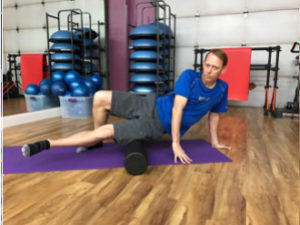 The iliotibial (IT) band is not a muscle, but a giant tendon running from the side of the hip to the knee. IT bands are notoriously tight which can lead to tenderness in the hip, knee, or even lower back.
The iliotibial (IT) band is not a muscle, but a giant tendon running from the side of the hip to the knee. IT bands are notoriously tight which can lead to tenderness in the hip, knee, or even lower back.
Getting on to your side lift up and gently lower your weight onto the roller on the outside of your thigh. rolling over the IT band is not the most effective way to mobilize it so gently rock your body forward and back very slowly to stretch the IT band away from the neighboring muscles. Explore sections of it all the way from your knee to your hip.
Glutes and Piriformis
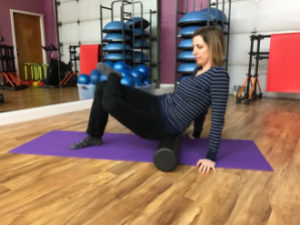 If you have ever suffered from the hip or low back pain or even sciatica then you are familiar with how uncomfortable tension in these muscles can be.
If you have ever suffered from the hip or low back pain or even sciatica then you are familiar with how uncomfortable tension in these muscles can be.
Sit on the foam roller with one ankle crossed over the opposite knee. This increases the length in your buttock. Lean back onto your hands to allow yourself to relax onto the roller then rotate towards the side of the crossed leg. Explore out towards your side and down towards your sit bones.
Calf Muscles
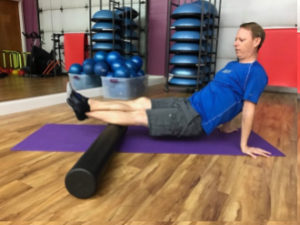 The calf muscles (mainly the gastrocnemius and soleus) tend to be tight in runners, bikers, hikers, those who wear high heels, and those who pronate their feet. Foot pain, knee pain, hip pain, and even lower back pain may result.
The calf muscles (mainly the gastrocnemius and soleus) tend to be tight in runners, bikers, hikers, those who wear high heels, and those who pronate their feet. Foot pain, knee pain, hip pain, and even lower back pain may result.
You can apply pressure by just reacting your calf on the foam roller or place one leg on top of the other to apply more pressure. For more leverage, use your arms to lift your hips off the ground and gently roll back and forth between the knee and the heel.
Quads and Hip Flexors
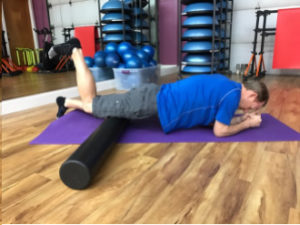 Quad are commonly tight in many people and can contribute to knee, hip, and low back pain. Remember that they are called your quads because they are made up of 4 different muscles so rock from side to side to be sure you are getting each of them.
Quad are commonly tight in many people and can contribute to knee, hip, and low back pain. Remember that they are called your quads because they are made up of 4 different muscles so rock from side to side to be sure you are getting each of them.
Get into a plank position with the roller under your quads. Using your forearms to roll thighs forward and back between your hip bones and knees. Bend your knee if you like and rock slowly from side to side. Be sure to not let your low back sway by keeping your abs engaged and keep your shoulders from hiking up off of your ribs or up towards your ears.
Lats
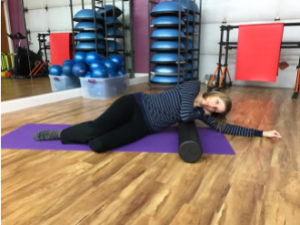 The lat, or latissimus dorsi, is a massive muscle on either side of the back of your torso. It is responsible for different arm motions (pulling downwards is the most common). Generally, the tension here results in pain around the ribs and scapula but it is a large muscle and can feel tight anywhere from the shoulder to the low back.
The lat, or latissimus dorsi, is a massive muscle on either side of the back of your torso. It is responsible for different arm motions (pulling downwards is the most common). Generally, the tension here results in pain around the ribs and scapula but it is a large muscle and can feel tight anywhere from the shoulder to the low back.
To isolate the lats in your foam rolling experience, lie down sideways with your arm overhead and position the foam roller below your armpit on your ribs. you can just gently rock forwards and backward to pin the lat. Use your hand to move the roller closer to your waist or your armpit since placing gall of your weight on the roller can be to much pressure.
Chest Opening
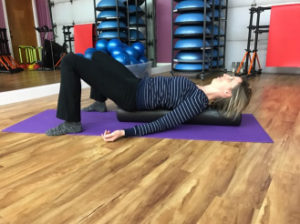 When we say “chest,” we mean the pectoralis major (the big main one) as well as the subscapularis of the rotator cuff. When people sit hunched over a desk or steering wheel for long periods of time, their chest muscles shorten and their upper back becomes rounded causing pain between the shoulder blades and into the neck.
When we say “chest,” we mean the pectoralis major (the big main one) as well as the subscapularis of the rotator cuff. When people sit hunched over a desk or steering wheel for long periods of time, their chest muscles shorten and their upper back becomes rounded causing pain between the shoulder blades and into the neck.
Simply lie lengthwise on the foam roller with your arms resting at your sides. For this one, you are not rolling, but simply hanging out with your chest stretched out like a T. After a minute, do some snow angels or chest flies with your arms to train the muscles to create even more length. Your posture will thank you.
Upper Back
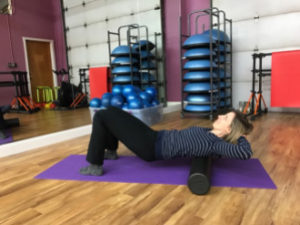 In the upper back the rhomboids, erectors, and trapezius muscles can be targeted by the foam roller. Often these few tight from lack of over or under use or pore posture but mobilizing them is still helpful.
In the upper back the rhomboids, erectors, and trapezius muscles can be targeted by the foam roller. Often these few tight from lack of over or under use or pore posture but mobilizing them is still helpful.
Place your hands on the back of your head to support your neck so it doesn’t fall backward. Gently bend your knees to lift you hips off of the ground then shift your upper body up and down on the roller.
If you have any questions and want advice regarding massage, don’t hesitate to contact us at Loosen Up Bodywork.
